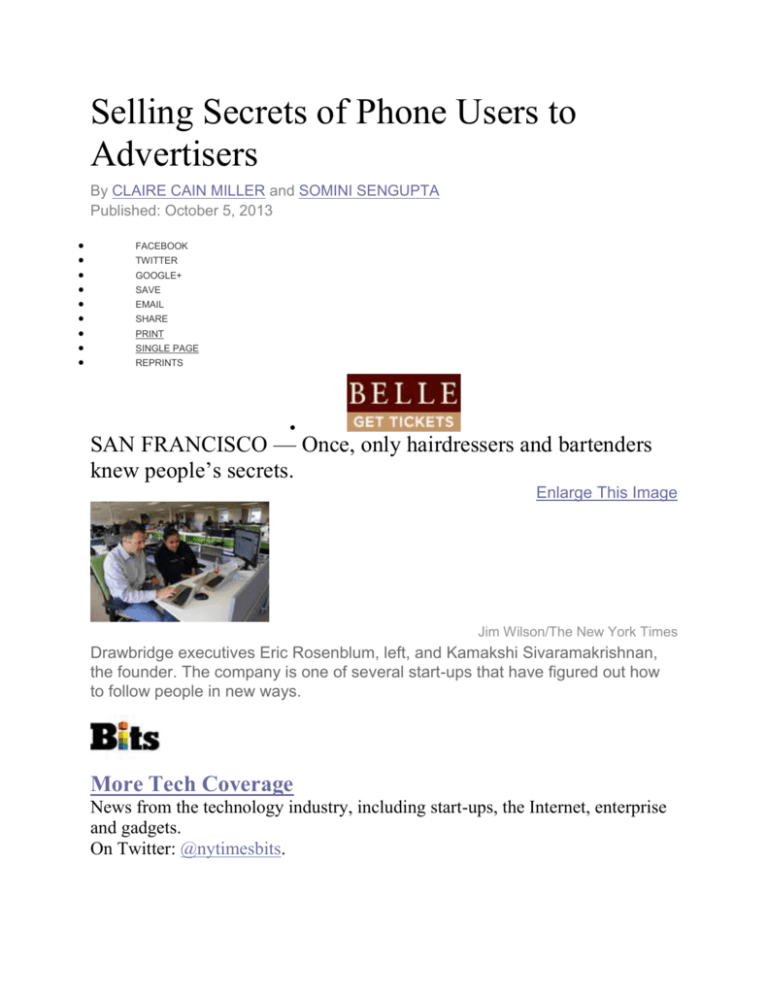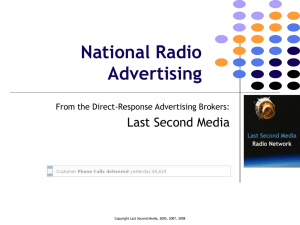Selling Secrets of Phone
advertisement

Selling Secrets of Phone Users to Advertisers By CLAIRE CAIN MILLER and SOMINI SENGUPTA Published: October 5, 2013 FACEBOOK TWITTER GOOGLE+ SAVE EMAIL SHARE PRINT SINGLE PAGE REPRINTS SAN FRANCISCO — Once, only hairdressers and bartenders knew people’s secrets. Enlarge This Image Jim Wilson/The New York Times Drawbridge executives Eric Rosenblum, left, and Kamakshi Sivaramakrishnan, the founder. The company is one of several start-ups that have figured out how to follow people in new ways. More Tech Coverage News from the technology industry, including start-ups, the Internet, enterprise and gadgets. On Twitter: @nytimesbits. Now, smartphones know everything — where people go, what they search for, what they buy, what they do for fun and when they go to bed. That is why advertisers, and tech companies like Google and Facebook, are finding new, sophisticated ways to track people on their phones and reach them with individualized, hypertargeted ads. And they are doing it without cookies, those tiny bits of code that follow users around the Internet, because cookies don’t work on mobile devices. Privacy advocates fear that consumers do not realize just how much of their private information is on their phones and how much is made vulnerable simply by downloading and using apps, searching the mobile Web or even just going about daily life with a phone in your pocket. And this new focus on tracking users through their devices and online habits comes against the backdrop of a spirited public debate on privacy and government surveillance. On Wednesday, the National Security Agency confirmed it had collected data from cellphone towers in 2010 and 2011 to locate Americans’ cellphones, though it said it never used the information. “People don’t understand tracking, whether it’s on the browser or mobile device, and don’t have any visibility into the practices going on,” said Jennifer King, who studies privacy at the University of California, Berkeley and has advised the Federal Trade Commission on mobile tracking. “Even as a tech professional, it’s often hard to disentangle what’s happening.” Drawbridge is one of several start-ups that have figured out how to follow people without cookies, and to determine that a cellphone, work computer, home computer and tablet belong to the same person, even if the devices are in no way connected. Before, logging onto a new device presented advertisers with a clean slate. “We’re observing your behaviors and connecting your profile to mobile devices,” said Eric Rosenblum, chief operating officer at Drawbridge. But don’t call it tracking. “Tracking is a dirty word,” he said. Drawbridge, founded by a former Google data scientist, says it has matched 1.5 billion devices this way, allowing it to deliver mobile ads based on Web sites the person has visited on a computer. If you research a Hawaiian vacation on your work desktop, you could see a Hawaii ad that night on your personal cellphone. For advertisers, intimate knowledge of users has long been the promise of mobile phones. But only now are numerous mobile advertising services that most people have never heard of — like Drawbridge, Flurry, Velti and SessionM — exploiting that knowledge, largely based on monitoring the apps we use and the places we go. This makes it ever harder for mobile users to escape the gaze of private companies, whether insurance firms or shoemakers. Ultimately, the tech giants, whose principal business is selling advertising, stand to gain. Advertisers using the new mobile tracking methods include Ford Motor, American Express, Fidelity, Expedia, Quiznos and Groupon. “In the old days of ad targeting, we give them a list of sites and we’d say, ‘Women 25 to 45,’ “ said David Katz, the former general manager of mobile at Groupon and now at Fanatics, the sports merchandise online retailer. “In the new age, we basically say, ‘Go get us users.’ “ In those old days — just last year — digital advertisers relied mostly on cookies. But cookies do not attach to apps, which is why they do not work well on mobile phones and tablets. Cookies generally do work on mobile browsers, but do not follow people from a phone browser to a computer browser. The iPhone’s mobile Safari browser blocks thirdparty cookies altogether. Even on PCs, cookies have lost much of their usefulness to advertisers, largely because of cookie blockers. Responding to this problem, the Interactive Advertising Bureau started a group to explore the future of the cookie and alternatives, calling current online advertising “a lose-lose-lose situation for advertisers, consumers, publishers and platforms.” Most recently, Google began considering creating an anonymous identifier tied to its Chrome browser that could help target ads based on user Web browsing history. For many advertisers, cookies are becoming irrelevant anyway because they want to reach people on their mobile devices. Yet advertising on phones has its limits. For example, advertisers have so far had no way to know whether an ad seen on a phone resulted in a visit to a Web site on a computer. They also have been unable to connect user profiles across devices or even on the same device, as users jump from the mobile Web to apps. More Tech Coverage News from the technology industry, including start-ups, the Internet, enterprise and gadgets. On Twitter: @nytimesbits. Without sophisticated tracking, “running mobile advertising is like throwing money out the window. It’s worse than buying TV advertisements,” said Ravi Kamran, founder and chief executive of Trademob, a mobile app marketing and tracking service. This is why a service that connects multiple devices with one user is so compelling to marketers. Drawbridge, which was founded by Kamakshi Sivaramakrishnan, formerly at AdMob, the Google mobile ad network, has partnerships with various online publishers and ad exchanges. These send partners a notification every time a user visits a Web site or mobile app, which is considered an opportunity to show an ad. Drawbridge watches the notifications for behavioral patterns and uses statistical modeling to determine the probability that several devices have the same owner and to assign that person an anonymous identifier. So if someone regularly checks a news app on a phone in bed each morning, browses the same news site from a laptop in the kitchen, visits from that laptop at an office an hour later and returns that night on a tablet in the same home, Drawbridge concludes that those devices belong to the same person. And if that person shopped for airplane tickets at work, Drawbridge could show that person an airline ad on the tablet that evening. Ms. Sivaramakrishnan said its pinpointing was so accurate that it could show spouses different, personalized ads on a tablet they share. Before, she said, “ad targeting was about devices, not users, but it’s more important to understand who the user is.” Similarly, if you use apps for Google Chrome, Facebook or Amazon on your cellphone, those companies can track what you search for, buy or post across your devices when you are logged in. Other companies, like Flurry, get to know people by the apps they use. Flurry embeds its software in 350,000 apps on 1.2 billion devices to help app developers track things like usage. Its tracking software appears on the phone automatically when people download those apps. Flurry recently introduced a real-time ad marketplace to send advertisers an anonymized profile of users the moment they open an app. Profiles are as detailed as wealthy bookworms who own small businesses or new mothers who travel for business and like to garden. The company has even more specific data about users that it does not yet use because of privacy concerns, said Rahul Bafna, senior director of Flurry. Wireless carriers know even more about us from our home ZIP codes, like how much time we spend on mobile apps and which sites we visit on mobile browsers. Verizon announced in December that its customers could authorize it to share that information with advertisers in exchange for coupons. AT&T announced this summer that it would start selling aggregated customer data to marketers, while offering a way to opt out. Neither state nor federal law prohibits the collection or sharing of data by third parties. In California, app developers are required to post a privacy policy and to clearly state what personal information they collect and how they share it. Still, that leaves much mystery for ordinary mobile users.






